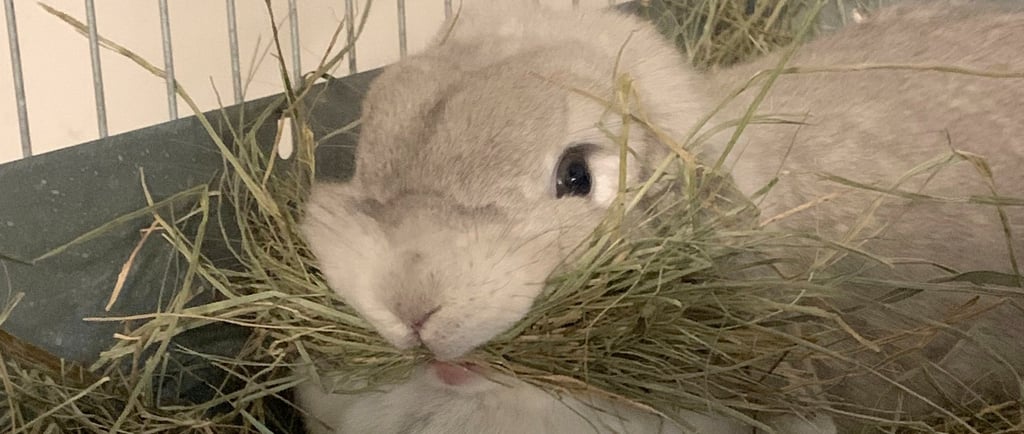Kindling: What Can Go Right, What Can Go Wrong
While we always hope the birthing process will be smooth for our mothers-to-be, we know that this isn't always the case. Read about the challenges of kindling.
Amy J.
10/23/20246 min read


Many people wrongly believe that rabbits have an easy time with the birthing process and that their litters are simple to raise. This may be true of some breeds, but is definitely not the case with Holland Lops. Conditions have to be just right for the kits to survive.
In an ideal world, a doe will give birth (the proper term is "kindle") quickly while ensconced in a lovingly prepared nest full of soft hay and fur pulled from her own chest for added warmth. As each kit arrives, she will clean it gently to remove all traces of the blood and goo that goes along with being born, and then cover the whole litter with more of her fur. Each morning and evening, she will return to the nest box and fill them with her warm, nourishing milk, taking time to inspect and tidy each baby until they are all ready to leave the nest and hop after her at two to three weeks of age.
It's an absolute joy when things go this smoothly and a doe is able to care for her little ones without any fuss nor muss. We have had some wonderful does who were such good mothers that we never had to worry over them and their ability to care for their young. Unfortunately, we have had just as many does who have kept us awake at night, with concerns that they will not do well with kindling nor become good mothers. So many things can go wrong at any step along the way.
Typically, a doe will prepare her nest box several days prior to her babies being due to arrive. Many breeders will give their bred does a box on a certain day of her pregnancy and let her get on with it. We have tried this practice, but it always seems to backfire on us. When given a box before they ask for it, our does will often use the nest box as an extension of their litter boxes, which results in wasted hay and additional time spent in cleaning and disinfecting the nest boxes for use when they are actually ready for them. For this reason, we wait until a doe "tells" us she wants her box, When we see her hopping around her cage with a tidy bundle of hay in her mouth (we call the the "haystache") we know she's anxious to build her nest. Watching a doe prepare her nest is one of the wonderful mysteries of life. She will nudge the box into her preferred location, hop in to inspect it thoroughly, and then begin adding the hay, bundle by bundle, searching for just the right pieces to use. Like an expert craftsman, she works methodically, using her nose and paws to push and pull the hay into just the right position before repeating the process with more hay. A nesting rabbit is like a thing obsessed, driven to complete her task. When she is satisfied with her work and has assured herself that she has created a cozy and safe place for her babies to be born, she will usually flop on her side for a bit of a rest and then begin hopping around in a normal manner, with all traces of the haystache-wielding maniac behind her.
What can go wrong with nest building? Some does refuse to build a nest in a box. Others build a lovely nest in the box but then abandon it when labor begins. A few just leave things to the last minute and hastily prepare a little mound as an afterthought, as though they didn't realize they were going to be raising babies. When born on the floor of a pen or cage space, furless newborn kits have no protection from being chilled or from being stepped on by their mother as she has her other babies. The hay in a nest box offers both warmth and cushioning protection from the mother's weight being born directly on their tiny bodies. Without this protective warmth and cushioning, the babies will be very cold, and will often receive internal injuries when born on the floor. Even when we are able to intervene quickly and rewarm them, the babies often succumb to their injuries, regardless.
The kindling process should only take 20-30 minutes. If a doe remains in the nest box for more than 45 minutes, we know things aren't looking optimistic for a good outcome. During kindling, one of the babies may become stuck in the birth canal and can cause its littermates to perish due to a prolonged labor and lack of oxygen. This baby may be in a poor position or it could be much larger than the others. All too often, a first-time dwarf rabbit mother will lose her litter in this manner. We often have mothers kindle two or more babies without any issues and, assuming all is well, we are surprised and dismayed to discover a stillborn kit or two on the floor of the cage or in the nest box several hours or even a day or two later.
If the baby bun makes it through the kindling process thus far, things are looking good, but there are still some potential bumps in the road, Normally mother rabbits clean their babies gently as each is born and quickly moves on to the next one. Occasionally a mother will "over groom" a baby, or even the entire litter. This means that, rather than just cleaning her kits with her tongue, she will involve her teeth in the cleansing process, causing injury or even death to the baby. We have had a baby lose a leg to over grooming, and another lost an ear. While these babies survived and went on to live wonderful lives with their beloved families, they are the exception rather than the rule. When over grooming begins, it often leads to cannibalism or to so much damage that the babies will not survive. This over grooming behavior is more typical in first-time mothers. When we discover this behavior in a doe, we promptly retire her from our breeding program and place her with a loving forever family.
After being groomed, the doe needs to take the time to cover her babies with lots of warm, soft fur from her chest and dewlap. Without this insulating layer, the babies can still become chilled and die. Some does only pull a bit of fur and call it a day. We need to intervene quickly and add supplemental fur to the litters which need it. This is where our pet French Angora, Sukie, earns her keep. When we groom Sukie, we keep her nicest wool and add it to the nests whenever needed, (after cutting it into shorter lengths, as the babies can get longer fur/wool wrapped around their necks or paws, becoming trapped or even strangled in it.) Other mother rabbits pull so much fur for their babies that it heaps out over the top of the nest box and can be seen floating around the rabbitry for days on end. A nice, happy medium is preferred.
Next, the babies need to be fed regularly. Ideally, this will occur twice a day, early in the morning and at some point in the evening. Most mother rabbits don't need assistance in the feeding of their babies, but they can get off to a slow start as their milk supply becomes established or as a first-time mother learns how to patiently feed them. We keep a close watch on all litters and look for nice chubby tummies after each feeding. If they appear thin or wrinkly, intervention is needed. This is accomplished by putting mother and babies into some sort of towel-lined basket or box, which is then covered fully with another towel or blanket to create a dark, cozy burrow. If the mama bun is nervous, I will gently pet her and give her cheek rubs so she can relax and let her milk down. Usually we can hear the babies nursing happily after a few minutes and continue in this manner for 5-10 minutes, so all the kits can eat their fill. Once all the babies are sporting cubby bellies, we return them to their nest box and everyone settles back into their cage space happily. It typically only takes a day or two of this type of intervention for the light bulb to go on in the mother's head and for the kits to become strong enough to be more aggressive in their search for food when the mama comes into the nest box for their feeding.
There is another feeding-related risk to a new baby, and that occurs when it's still nursing, the doe decides meal time is over, leaping out of the box and inadvertently taking the baby with her, while still nursing. This has happened on more occasions than we care to remember and we've learned to cover every inch of the cage space floor with warm layers of blankets and fleece mats, just in case a baby needs to burrow its way into a cozy spot until we discover its misadventure and can return it to the nest box. As long as the baby can find a warm spot to hunker down in, it will be okay.
If the babies are able to survive the birthing process and the first week of life, there is a strong likelihood that they will do well in life. There are other potential pitfalls (i.e. a doe suddenly stops producing milk or develops mastitis), but. for the most, part, the most challenging aspects of survival have been overcome.
After reading about all the ways things can (and do!) go wrong, is it any wonder that we love and cherish each of these babies and treat it as a little miracle to be celebrated?
